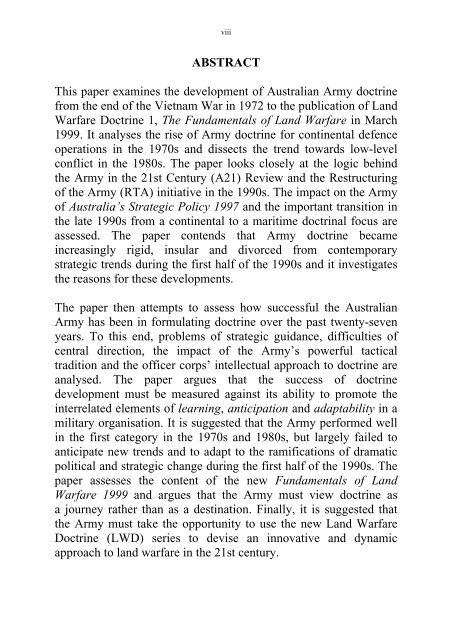Ibid - Australian Army
Ibid - Australian Army
Ibid - Australian Army
Create successful ePaper yourself
Turn your PDF publications into a flip-book with our unique Google optimized e-Paper software.
viii<br />
ABSTRACT<br />
This paper examines the development of <strong>Australian</strong> <strong>Army</strong> doctrine<br />
from the end of the Vietnam War in 1972 to the publication of Land<br />
Warfare Doctrine 1, The Fundamentals of Land Warfare in March<br />
1999. It analyses the rise of <strong>Army</strong> doctrine for continental defence<br />
operations in the 1970s and dissects the trend towards low-level<br />
conflict in the 1980s. The paper looks closely at the logic behind<br />
the <strong>Army</strong> in the 21st Century (A21) Review and the Restructuring<br />
of the <strong>Army</strong> (RTA) initiative in the 1990s. The impact on the <strong>Army</strong><br />
of Australia’s Strategic Policy 1997 and the important transition in<br />
the late 1990s from a continental to a maritime doctrinal focus are<br />
assessed. The paper contends that <strong>Army</strong> doctrine became<br />
increasingly rigid, insular and divorced from contemporary<br />
strategic trends during the first half of the 1990s and it investigates<br />
the reasons for these developments.<br />
The paper then attempts to assess how successful the <strong>Australian</strong><br />
<strong>Army</strong> has been in formulating doctrine over the past twenty-seven<br />
years. To this end, problems of strategic guidance, difficulties of<br />
central direction, the impact of the <strong>Army</strong>’s powerful tactical<br />
tradition and the officer corps’ intellectual approach to doctrine are<br />
analysed. The paper argues that the success of doctrine<br />
development must be measured against its ability to promote the<br />
interrelated elements of learning, anticipation and adaptability in a<br />
military organisation. It is suggested that the <strong>Army</strong> performed well<br />
in the first category in the 1970s and 1980s, but largely failed to<br />
anticipate new trends and to adapt to the ramifications of dramatic<br />
political and strategic change during the first half of the 1990s. The<br />
paper assesses the content of the new Fundamentals of Land<br />
Warfare 1999 and argues that the <strong>Army</strong> must view doctrine as<br />
a journey rather than as a destination. Finally, it is suggested that<br />
the <strong>Army</strong> must take the opportunity to use the new Land Warfare<br />
Doctrine (LWD) series to devise an innovative and dynamic<br />
approach to land warfare in the 21st century.

















